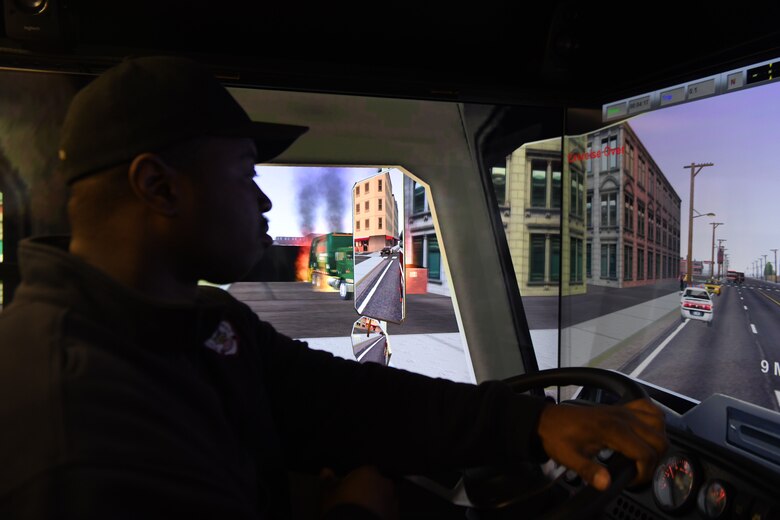 |
| Jonathan Matthews, a 97th Air Mobility Wing Fire Department firefighter, drives a firetruck driving simulator Jan. 15, 2019, at Altus Air Force Base, Okla. The simulator comes with scenarios built in, but can also be customized for brand new scenarios, allowing firefighters to hone their skills in a variety of situations. (U.S. Air Force photo by Airman 1st Class Jeremy Wentworth) |
By Airman 1st Class Jeremy Wentworth, 97th Air Mobility Wing Public Affairs /
Published January 24, 2019
ALTUS AIR FORCE BASE, Okla. (AFNS) -- The 97th Air Mobility Wing Fire Department has made its dedication to innovation clear with the addition of three simulators to assist in training.
One simulator allows firefighters to use virtual reality to practice fighting fires with a hose and one is a trainer for the pump systems on a firetruck. They can cover a large amount of what goes into fighting a fire but the newest simulator fills the gap.
“It’s a driving simulator,” said Philip Fourroux, 97th AMW Fire Department fire chief. “It allows us to train how to drive at a really low risk.”
The simulator is equipped with four 55” LED displays and a driving cab complete with a driver’s setup, a passenger seat and a hydraulic system similar to the aircraft simulators also found on base.
“Obviously, the controls aren’t perfect,” said Fourroux. “You are never going to fully replicate the feeling of driving. It’s the muscle memory that this allows us to teach; that’s invaluable.”
While the three simulators are not necessarily focused on the military or manufactured with the intent to work together, the fire department created an innovative solution where all three now work together in a single process.
“We got in contact with the makers of the pump system trainers,” said Fourroux. “The remade pumps look exactly like the pump system on our trucks. With the firefighting simulator, we worked to get a C-17 (Globemaster III) in there to work on aircraft fires.”
The simulators are run by trainers who incorporate the simulations into a chronological event.
“We can start out with driving the fire truck,” said Fourroux. “Once they get to the scene, they can hop over to the pump simulator and get everything ready before they get on the VR headset and actually fight the fire. We’ve incorporated our five-level upgrade training in the systems to the Airmen can practice before the real thing.”
The simulators are saving money and resources for the base and improving current and future operations.
“Every time we go out there to train, we’re using resources and putting wear on our gear,” said Fourroux. “We have to go out and do a driving course on every vehicle. When we go out there and practice in the vehicles themselves, we’re putting wear on them as well as putting a vehicle out of commission for that time. With the simulators, we can train and get the feel for it before we even go out. It cuts hours and saves thousands of dollars.”
With the evolution of technology, the next generation of Airmen are receiving opportunities that older generations could not have dreamed of.
“As a young firefighter, this would’ve been invaluable,” said Fourroux. “The extra training that they get puts them miles ahead of anyone in their shoes 50 years ago. It’s only going up from here.”



